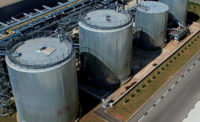In our world of growing concerns with global warming, utility companies across the world are making energy storage more cost effective for energy users. Initially, energy storage was developed to reduce the energy cost to the customer. However, there are many more issues which now benefit the utility companies, hence the rebate and incentive programs offered to get customers to implement energy storage.
Some of these issues include reduced water usage goals, reduced carbon footprint goals, LEED certification, and grid stabilization to integrate more renewable forms of energy. There are many ways to capture the cost savings of energy storage, but here are the top four ways to capture those cost savings to show the financial viability of energy storage.
AREA #1 – UTILITY INCENTIVES
Utility companies across the world have their own versions of energy storage incentives, but those implemented promote generating and storing energy when demand is low. In California, the incentives were developed largely to help integrate more forms of renewable energy onto the grid. Energy storage helps stabilize the grid when renewable energy is not available or losing capacity (typically when the peak demand is seen during the afternoon on weekdays). The investor-owned utility companies will pay an incentive on a $/kW basis, and that is based on the kW shifted from the peak summer rate period on a peak cooling day. This is typically from 12:00 p.m. – 6:00 p.m. The baseline is set by an energy model calibrated to the existing building’s energy bills on a kW and kWh basis.
We highly recommend hiring an experienced professional in the practice of processing energy storage incentives when applying for incentives or rebates. It is not a simple process, and there are ways that incentives can be denied by not following the proper procedure. For example, if your local utility company provides incentives, the application must be approved before any construction starts or invoices are fulfilled. Incentives are set in place to encourage customers to spend the extra money to install more energy-efficient, grid-friendly systems. This is opposed to rebates, which are implemented after the fact. It is important to note that incentives must be approved by the utility company, typically done by a third-party engineer, before the project is started.
When estimating the utility incentive, simple calculations using some basic assumptions can provide good budget numbers. For this example, we’ll use the Southern California Edison (SCE) incentive for energy storage, which is $875/kW shifted, and a Calmac thermal storage ice bank system with chillers cooling a 500-ton load. The SCE utility company has assumed that air cooled chillers operate at 1.2 kW/ton and water cooled chillers operate at 0.5 kW/ton. We’ll use these assumptions for our calculations.
Example 1: Energy Storage incentive for air cooled chiller with full storage
Assumptions
• 500-ton peak load
• Incentive of $875/kW reduced
• Air cooled chiller 1.2 kW/ton
• Full storage, chiller off during peak times
Calculation
- Peak load (tons) * unit efficiency (kW/ton) * incentive amount ($) = incentive amount ($)
500 tons*1.2 kW/ton*$875/kW = $525,000
Example 2: Energy Storage incentive for water cooled chiller with full storage
Assumptions
• 500-ton peak load
• Incentive of $875/kW reduced
• Water cooled chiller 0.7 kW/ton
• Full storage, chiller off during peak times
Calculation
Peak load (tons) * unit efficiency (kW/ton) * incentive amount ($) = incentive amount ($)
500 tons*0.7 kW/ton*875$/kW = $306,250
These incentive levels can make a very significant impact on the additional project cost compared to a typical chiller plant design. These examples are for full storage, which assumes the chillers are completely off during peak hours. There are options for partial storage where the thermal storage will cover, typically, 2/3 of the cooling load and the chiller will cover the remaining 1/3. This often will provide the best simple payback due to balancing the added capital cost of adding a full-capacity thermal storage system as well as a full capacity chiller. Working with an energy services team will help determine if this is the most viable solution for your project. Example 3 and 4 show the possible advantages of a partial storage system compared to the full storage examples of 1 and 2.
Example 3: Energy Storage incentive for air cooled chiller with partial storage
Assumptions
• 500-ton peak load
• Incentive of $875/kW reduced
• Air cooled chiller 1.2 kW/ton efficiency
• Partial storage, chiller at part load (33%) during peak times. 66% reduction
• Additional capital cost for full storage is $650,000
• Additional capital cost for partial storage is $435,000
• Annual cost savings from energy savings during peak hours $25,550 for full storage
O Determine from energy modeling
• Annual cost savings from energy savings during peak hours $20,250 for partial storage
O Determine from energy modeling
Calculation
- Full Storage Incentive:
500 tons*1.2 kW/ton*875$/kW = $525,000
- Partial Storage Incentive:
500 tons*(0.66)*1.2 kW/ton*875$/kW = $175,000
- Simple payback for full storage
(Additional capital cost - incentive)/cost savings per year = simple payback
($650,000-$525,000)/$25,550 = 4.9 years
- Simple payback for partial storage
(Additional capital cost - incentive)/cost savings per year = simple payback
($435,000-$350,000)/$20,250 = 4.2 years
Example 4: Energy Storage incentive for water cooled chiller with partial storage
Assumptions
• 500-ton peak load
• Incentive of $875/kW reduced
• Water cooled chiller 0.7 kW/ton efficiency
• Partial storage, chiller at part load (33%) during peak times. 66% reduction
• Additional capital cost for full storage is $450,000
• Additional capital cost for partial storage is $285,000
• Annual cost savings from energy savings during peak hours $24,450 for full storage.
O Determine from energy modeling
• Annual cost savings from energy savings during peak hours $16,000 for partial storage
O Determine from energy modeling
Calculation
- Full Storage Incentive:
500 tons*0.7 kW/ton*875$/kW = $306,250
- Partial Storage Incentive:
500 tons*(0.66)*0.7 kW/ton*875$/kW = $204,167
- Simple payback for full storage
(Additional capital cost - incentive)/cost savings per year = simple payback
($450,000-$306,250)/$24,450 = 5.9 years
- Simple payback for partial storage
(Additional capital cost - incentive)/cost savings per year = simple payback
($285,000-$204,167)/$16,000 = 5.1 years
These examples show how the partial storage can provide a more attractive simple payback. The cost savings per year are less, but the capital cost is less as well. It’s important to determine how projects are evaluated when presenting energy projects such as this. There are other ways that can show the full storage as more attractive, but using the above assumptions and calculations can help estimate the incentive amounts expected from energy storage projects.
AREA #2 – TAX INCENTIVES
There are many various government financial incentives as well. Here in the United States, the federal government has implemented the Energy Policy Act of 2005 (ePact) to provide tax relief for energy conservation projects. The credit comes in the form of a deduction on your tax form. The amount typically applied is $1.80/sq ft, which is based on the energy usage compared to the ASHRAE 90.1 2001/2007 standard.
To receive the full ePact tax rate, an engineered energy model must be generated to show that the energy cost is a certain percentage (50% for the full $1.80/sqft) below the ASHRAE standard. This is an addition of three energy conservation areas. The thermal storage portion can get $0.60/sq ft, but working with a tax professional can allow you to show that your lighting and envelope meet the requirements to get the full $1.80/sq ft. Here is a quick example from Raymond Kumar, CPA at Energy Tax Savers.
“Let’s use a commercial building performing a $195,000 thermal storage project. The building is 83,334 sq ft and is approved for the full $1.80/sq ft tax deduction (this includes the $0.60/sq ft for the thermal storage and $1.20/sq ft for the lighting and envelope). This is a $150,000 tax deduction (83,334 sqft*$1.8/sq ft). Typically, the building owners would deduct $5,000/yr for 39 years, but with the ePact program, they can deduct $150,000 in year one and the remaining $45,000 over the next 39 years.”
AREA #3 – ENERGY USAGE
In the first four examples, we showed energy savings per year from energy storage. To accurately capture those energy usage savings, it is best to use energy modeling. There are simple ways to calculate costs savings by using blended utility rates, but this method misses the advantages of energy storage. Because of demand charges and time-of-day energy charges, there are huge differences between the daytime and nighttime cost of electricity. In the summer months, the cost of day time electricity is four times the cost of night time electricity for many commercial buildings and roughly twice as expensive in the winter months. Using a blended rate for electricity costs over the course of a day ignores this large day/night differential in costs.
We’ll use California’s Southern California Edison (SCE) tariff structure as an example, but this structure is almost universal for commercial customers. SCE has three separate charges based on the hours of the day and month of the year. This is based on the grid’s demand and what power source they must generate the power from. Below is an example structure from the SCE TOU-8 program.
The nighttime cost of electricity is about $0.05 during off peak hours, compared to approximately $0.20 per kWh during on-peak hours in the summer months. To capture the cost savings of running a thermal storage system at night to store energy and use the stored energy during the day, the cost during each of these times must be calculated separately. The most accurate way to do this is using an energy model. Energy model systems will allow the user to input the time of use tariff structure and the software will calculate the energy/cost per time period. Some of the common programs used are Trace 700, eQuest, and MATLAB, but there are many other reliable programs.
AREA #4 – ENERGY DEMAND
In addition to capturing annual cost savings from the energy usage, it’s just as important — maybe more important — to capture the savings from the demand charges. The demand charge is calculated differently than the energy usage charge. Demand charges are applied to the largest kW demand average for 15 minutes during each month. There are two demand charges. One based on the on-peak period, and a second demand charge that is independent of the time of day. This is often the primary annual cost savings from an energy storage system.
The kW demand peak of a building typically happens during the day when the building is occupied. For most commercial buildings, this will occur in the afternoon. This is an accumulation of the interior lighting, plug loads, and air conditioning system. When a portion of the air conditioning system is turned off during the peak time the overall kW will be reduced. Example 5 below shows an example of a building similar (slightly larger) to the calculations in Examples 1-4.
Example 4 shows that the demand cost savings can be a significant portion of the annual savings from a thermal storage system. Using a blended cost for energy will not capture these savings and shows an energy storage project that looks less financially attractive.
When utilizing batteries or other direct energy storage, the energy storage system will simply be depleted during the peak demand times to shave off the peak kW being pulled from the grid. To capture these savings, the kW used from the energy storage system will directly be multiplied by the kW charge. If this is used in conjunction with thermal storage where portions of the air conditioning system is also turned off, the kW demand could be significantly reduced, providing large cost savings.
There are more ways to capture savings, such as reduced maintenance savings from upgraded controls support and carbon credit sales, but the above are the top four ways to capture savings. Partnering with a company that does thermal storage will help make your project go more smoothly and help procure all the various way to capture cost savings. ES
References
1. Andrews, T. “Thermal Energy Storage and Permanent Load Shifting Programs” 2015
2. Scott-Kakures, M. “Schedule TOU-8 Time-Of-Use-General Service-Large” January 29, 2014
3. Southern California Edison. “Permanent Load Shifting Program, Program Guidelines” 2015
4. 109th Congress. “Energy Policy Act of 2005” August 8, 2005





